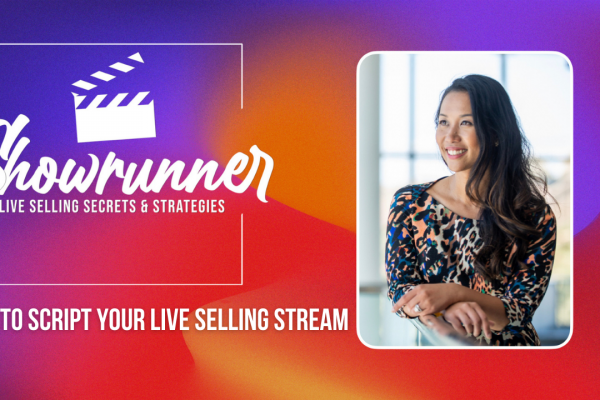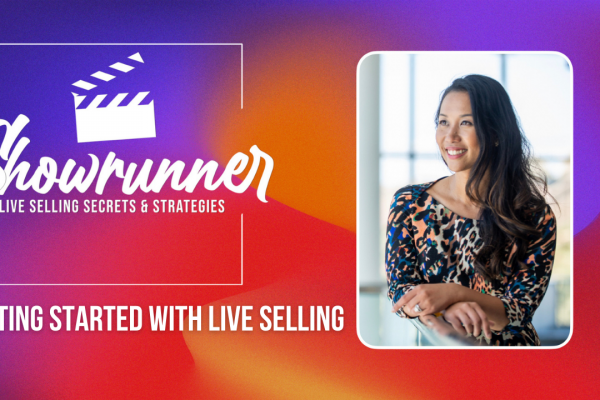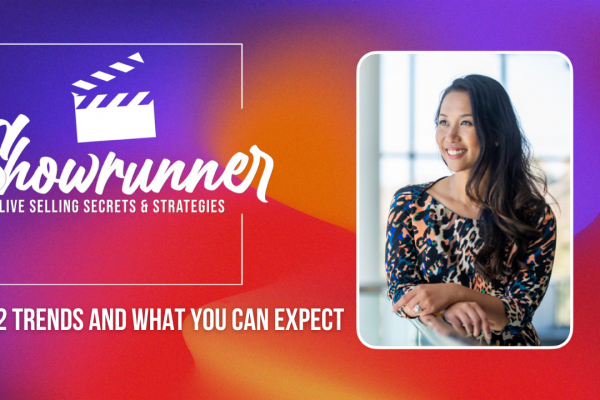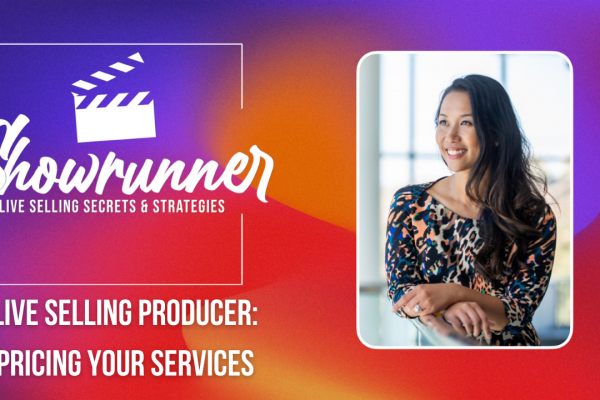Live selling is projected to become a $25 billion market by 2023. Yes, billion.
If you think about it, live commerce blends together entertainment and instant checkouts. It offers retailers, brands, and content creators a new channel to reach and engage audiences. It’s no secret that live shopping is on the rise. You can now shop on Amazon Live, Facebook, Instagram, TikTok, YouTube… the list goes on.
Live shopping is not just a trend; it’s the future of retail.
In this post, we’re going to
- Explore the future of live selling
- Introduce you to the live shopping platforms
- Talk through the process of how you can from live streamer to live shopping producer
Watch the full episode
On this season of Showrunner, we’re jumping into the world of live selling. Blending entertainment with instant checkouts, live commerce offers retailers, brands, and content creators a new channel to reach and engage audiences. Live shopping has opened doors for on-camera talent, influencers, and even remote live video producers. So listen, if you’re not already offering remote live video production to e-commerce clients, NOW is the time to get started.
Live Selling Trends
I’m Stephanie Liu. I’ve been producing live shopping events for big brands like Tampax, P&G, Once Upon a Farm, and more. I’ve been learning all about how the platforms work and what brands, celebrities, and influencers need to sell (and shine!)
When we talk about live streaming and live shopping in general, that industry is estimated to be worth $35 billion in the United States by 2024. If we talk about this in comparison to what’s happening in China, it pales in comparison, but that doesn’t mean that brands aren’t paying attention.
There is so much to learn from what China is doing. These big brands that I’ve been working with, they’re paying attention. They’re watching and analyzing these streams. Businesses of all sizes are seeing how these platforms are actually integrating the checkout process.
And if the big brands are paying attention, we should be, too.
This is your opportunity to start deciding. How do you want to separate yourself from the sea of sameness?
The Shift from Live Video Strategist to Live Selling Producer
Because if you’ve been following me over the years, I started out as a content creator. Then I started working with brands. Then it was about creating mini episodes, mini series, all the things. And then it moved into producing for other clients. I’ve produced shareholder meetings, investor meetings, virtual summits, and more.
Now what we have is e-commerce entering into the chat, entering into the arena and saying, we need a live video producer for our live selling events. That’s you and me. This is where the opportunity is going to be – in this new world of live shopping and selling.
When we talk about live shopping, a lot of people are always asking what are the biggest categories that are out there? Apparel and fashion? Yes. Apparel and fashion probably makes up about 36% of livestream shopping events, but that doesn’t mean that there aren’t other categories for you to dive into.
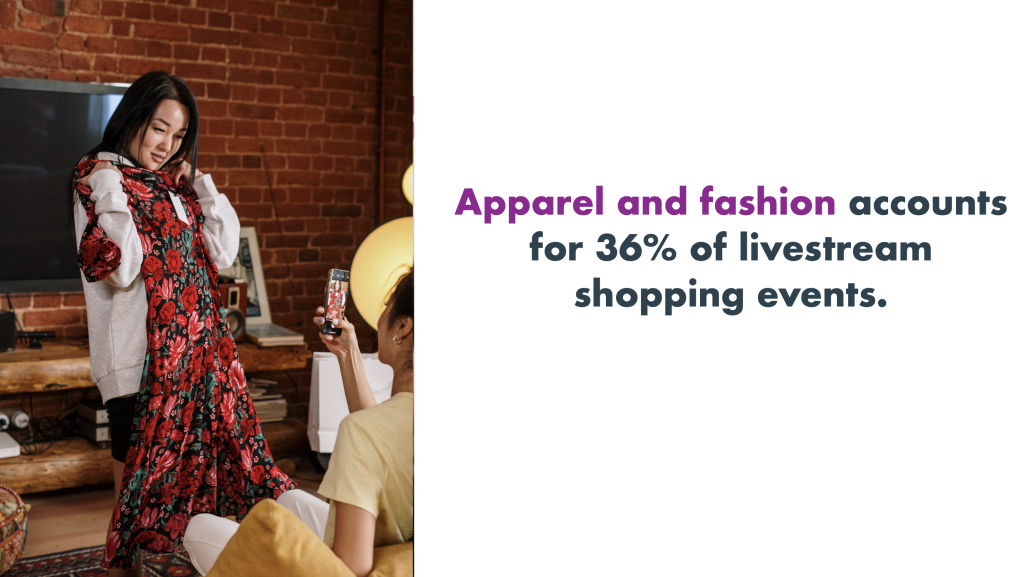
If you want to broaden your experience as a live selling producer, you should be thinking about what categories you really want to be a part of. There’s beauty, fashion, consumer electronics, home goods, consumer packed goods… all these different things. When you have the opportunity to start branding yourself, make sure you think about what you want to be known for. Start thinking now about your niche.
When I first started live streaming I would tell people, “I help brands and entrepreneurs go from unknown to unforgettable by leveraging live video.” And that statement told people the value that I bring. It allowed me to charge with confidence.
There are a ton of live streaming platforms out there from Amazon Live to Facebook Live to Livescale.tv and beyond. But here’s the thing… when you’re working with brands, they want to start owning their platforms. They don’t want to give a cut to all of those other live shopping platforms that are out there. And so while those are good to know, I feel like you should already have those under your belt before you start producing live selling events.
And if you don’t, then we’ll still talk about those too, but I’m really here to elevate your skills because for you as a live selling producer, you should know the difference between the advantages of YouTube live shopping versus Instagram live shopping. Let’s cut to the chase: one is 16×9 and the other is 9×16. One is connected to a marketplace. The other, you’d need to integrate with 3rd party shopping platforms.
The popularity of livestream shoppings platforms in the U.S. is something for you to be mindful of. If you don’t know what’s happening on any of these social media platforms, as far as how they’re integrating instant e-commerce checkout, now is the best time to start learning more. We’re all done with Q1 of 2022 and every single one of these platforms has already put out their earnings reports.
Live Video Producers vs. Live Selling Producers
When I say live selling producer, I want to make a clear distinction on the difference between a live video producer and a live selling producer.
When I tell people that I’m a live video strategist, it means that I help people strategize and figure out how to go from unknown to unfreaking forgettable. We talk about run of shows. And about on-camera talent. We’re discussing all those different things. When you think about a live selling producer, now you’re getting more niche, right?

So the live selling producer is responsible for developing programming and producing a live shopping stream that blends entertainment and e-commerce. That’s really important for you to remember because a lot of times I feel like when clients come to me and they want to do a live shopping stream it is very rigid… very vanilla. If you’re familiar with Ecamm Live and all the wonderful things it lets us all do, then you know that we have to inject excitement and promote engagement in our streams. People aren’t going to buy if they’re bored. They want to see demos. They want their questions answered.
This is your opportunity to dive in and differentiate yourself from the sea of sameness. So as a live selling producer, you’re responsible for more than just switching scenes. You’re producing an event.
And it’s because of the value, the insights that you have to offer, that’s really going to help the client reach their goals. Let me explain why that’s so important. Generally, what happens is that you will have a client that is interested in doing live selling. They have this idea, maybe they have extra budget, maybe it’s experimental budget.
And then what you also have is a live shopping platform, whether it’s the social media platforms or it’s something like livescale.tv, these live shopping platforms know how they function as a live shopping platform. They know the basics, but what they don’t have is YOU. Live selling producers are the conduit between what the client is envisioning and what the platform can offer.
What should the stream look like? Sound like? A live selling producer is the person who is going to work to bring that to life. But even as you’re building that, you still have to be aware of the requirements for the live shopping platforms.
Because as I said before, some of them stream in 9×16. Some of them are 16×9. Some of them are even 4×3 aspect ratio, which threw me for a loop. But thankfully, I have Ecamm and I was able to make quick changes to make sure the stream looked great at that aspect ratio. In the end, you have to be aware of what the user interface is. Not only on the producer side, but from the consumer’s perspective.
Oftentimes when we’re doing the storyboard for a live selling event, I have to say what happens on the live shopping platform? Does the product appear down here? Is it up there? Like where specifically is it? Because I’ll be damned if my talent is standing right here. And then all of a sudden there’s like a product like floating above his or her face.
So yes, you are going to be the conduit between the brand and the live shopping platform. As a live selling producer, you have so much to offer. And I want you to be mindful of that. If you haven’t looked at LinkedIn at job descriptions for what a live selling producer does, this is your opportunity to do that because now I’m already planting the seed.
Do you have a have a landing page? It’s time to update it. No landing page? Start researching. Now we know what a live selling producer does. Now I’ve given you a heads up as far as what to expect, as far as your role goes.
What to Expect as a Live Selling Producer
Let’s talk about what else you can expect when it comes to live selling. When I work with clients, I am not just a scene switcher, I am your producer. I also come from an agency background where I’ve had more than two decades of experience in the marketing world.
So when you come to me and you say, Stephanie, we want to have a live shopping event, this is everything that I bring to the table. I want to know what are your analytics? What’s your creative? How about your paid media? What about your earned media? And your SEO? This is coming from me as far as being a marketer and having this in my back pocket, because this is what separates me from the sea of sameness.
You have to think about for you as a live selling producer. What’s your niche? Whatever it is, that’s your specialty. Remember that when you’re pitching clients, you’ll want to be able to stand out and show that you can bring value. Think about how you’re positioning yourself.
Remember that when brands come to you or are thinking about doing live selling, you’re likely going to be talking to their marketing manager or PR team. Those people don’t know about live streaming. It’s not their forte. It’s not what they live and breathe for, like you and me. We think about this all the time. We think in intros, hooks, teasers, overlays… all the things that’s in our playground. And so when they come to you, they’re looking for your guidance and expertise.
When I was live producing, I didn’t really worry as much about the platform or the call-to-action, but in live selling those aspects are key. How long you put a promo code on screen. And hey, it can’t just be an overlay graphic because it needs to have a sound effect. It needs to be a pattern interrupt and catch attention.
Client Onboarding as a Live Selling Producer
Be mindful of your client onboarding process. What separates you? This is a non-negotiable. I will say you need to sit down with the client, the PR team, and the live shopping platform to really understand all of those different nuances so that you, as a producer, understand their reason why.
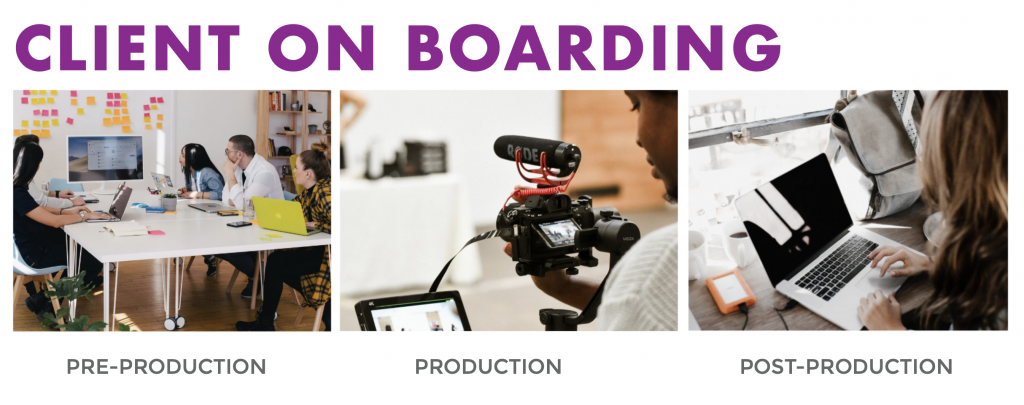
I was once in a live shopping event where all of a sudden the live shopping platform made an update and said, “hey, we’re not going to do four by threes anymore. We’re just going to make it sixteen by nine.” So when we went live, all of our graphics were four by three. The whole production was four by three.
Everything looked all stretched out. It didn’t look the way that we wanted to. And thankfully, I was using Ecamm Live so I just went into my Profiles, duplicated the Profile and changed it. Boom. And we were good to go.
A live selling event is different than a live show or stream. As a producer, you’ll be dealing with the on-screen talent (or talents), the platform, and the brand. You’ll need to figure out who is doing what during the client onboarding experience. If your client is really comfortable with the platform, then you may have them handling the platform while you do the rest. It depends on what their budget is going to be.
You are also responsible for a studio diagram. And we all know this because the Ecamm Fam is smart. You’re producers, you’ve done this. You go live. And this is a part of you. This is like the air that you breathe.
Live Selling Presenters
But I will tell you that when you’re in the live selling production role, it’s a completely different game. So I want you to start thinking about what is your client onboarding process? What is your checklist? What are your diagrams? Because generally what happens is that if a brand is trying to work with a celebrity or even an influencer, yes, they’ll have an amazing social media following and whatnot, but you put them in front of the camera and they’re like a deer in headlights.
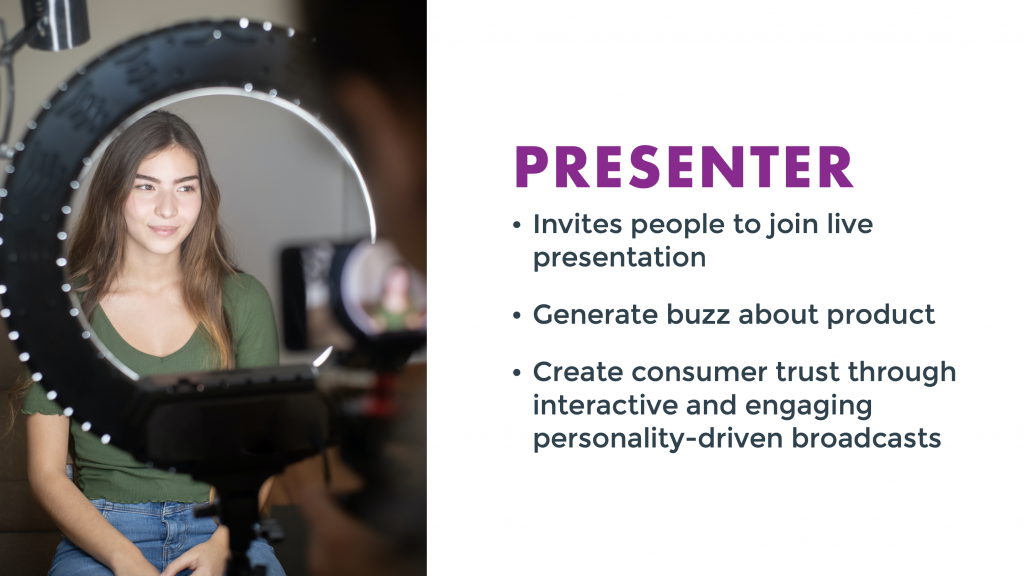
A lot of times when these brands are bringing on influencers, they’ll focus on casting. They don’t do an on-screen test. And more often than not the first time that an influencer has ever gone live is during the tech rehearsal. So please make sure that you’re giving yourself enough lead time for all of that.
Remember as the live selling producer, you have to be upfront with your clients. The presenter can make or break a live shopping event. The presenter has to be the one that’s inviting people to join the live presentation, tell them what’s it about, they need to have that excitement. You know what I’m saying? There’s a difference between seeing someone on Instagram and putting them in front of a camera. Can they speak clearly and concisely? Can they motivate someone to buy?
If a client brought on a data scientist or a product specialist, and they’re talking about, oh, this is how many HDMI ports and blah, blah, blah. And it’s okay, that’s not sexy that doesn’t make me want to buy.
You have to sell me on the idea of how this product is going to make my dream come true, how it’s going to unlock all these opportunities. And so having someone that’s familiar with the product that can speak passionately about it is going to be absolutely helpful.
As the producer, part of your job will be motivating and training that presenter to do their best. Remind them to look at the camera and move their hands.

When you’re talking about the presenter, they have to invite the people, they have the generate buzz about the product you, sometimes when brands are working with these influencers are moving from one campaign to another campaign and they may not have spent enough time to really understand the product.
And so when you come through and you ask me a question about, let’s say the Stream Deck or the Elgato FaceCam, I could speak to it. I use my Elgato key lights all day, every day, whenever I need to. Elgato products are my jam and I could speak about most of their products with passion. I have stories, and metaphors, case studies, and all sorts of things that I could share to help a buyer overcome their objection about purchasing a particular product.
If it’s an influencer that has never touched the product, if it’s an influencer that has never really worked with the product, they can’t come up with that stuff on the fly. And you can tell because you can see if they’re trying to read off a teleprompter. You can see immediately whether it’s genuine or not.
Presenters should generate buzz. They’re creating consumer trust through interactive and engaging personality driven broadcasts.
Another thing to keep in mind as you’re working with presenters is that most live shopping hosts aren’t used to seeing comments come through. They’re not used to seeing questions and comments show up. As a producer, it’ll be your job to control those questions. Open a Google Doc and paste the questions in and then send them along to the show host to let them go through them at the appropriate time. Remember, they may not be used to comments. Seeing all of those comments might feel totally overwhelming.
Be Mindful
As a producer, you need to be mindful about what’s happening behind the camera. Especially If you’re going to be onsite. A lot of times I try to tell producers, the host is looking at you. And so if you’re smiling, you’re basically telling them that they’re doing a great job. You’re giving them a thumbs up that gives them the confidence that they should keep going.
Sometimes we’re so engaged in our work that we end up looking mean or angry just because we’re focused. That can really throw off your show hosts.
Again, you could have a one producer that is managing the event in Ecamm and then another producer that is managing the live shopping platform. There’s going to be a delay as the video moves from Ecamm Live through the live shopping platform to the viewer. Make sure that everyone is wearing headphones, that there is no feedback happening.
All of the above information is important and should be included in a kickoff call when you’re onboarding a new client. It should be part of your live selling onboarding process.
A Word on Streaming Gear
OK, let’s talk for a moment about gear. As a live shopping producer, I don’t supply gear to my clients. I put together a recommended list and send it along to the client. I expect my clients to have that gear or something similar.
If you’re getting into this, I recommend that you set up an Amazon Associates account and a kit.co account. This will let you get some additional revenue by recommending gear to your clients. You could also create a “studio in a box” and sell the full kit to clients. That’s up to you and what works best for your business model.
Live Shopping Platforms
There are a ton of platforms out there and they fall into a few different categories:
- Marketplace
- White Label
- Social Platforms
- Event Based
- Virtual Assistance
At the time of this show (2022), here is what the live selling landscape looks like.
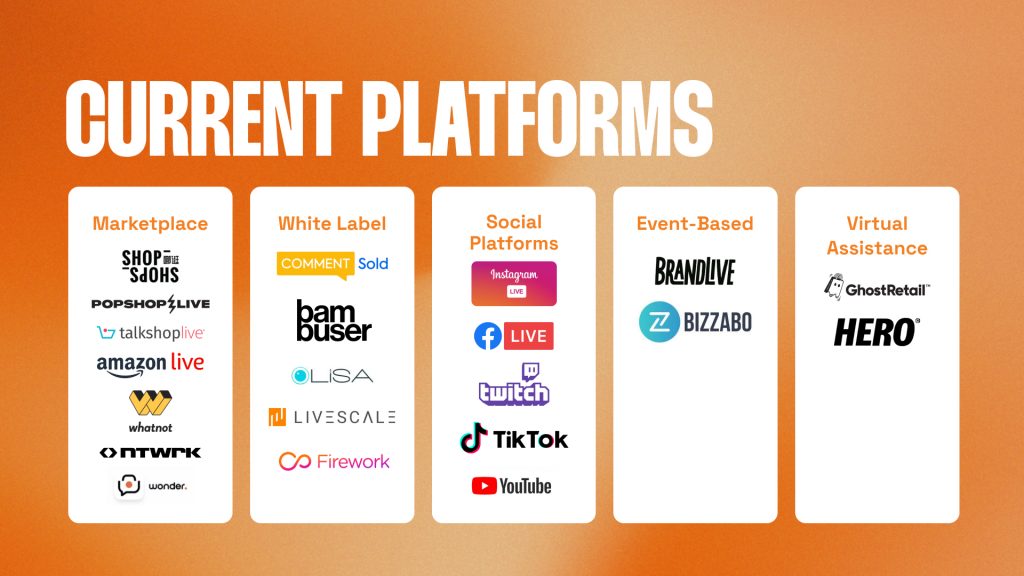
A marketplace means that there are already customers (and brands) on there. They’re used to the platform. Think Amazon Live. Think about all of the brands and businesses who use Amazon Live. There’s an awesome opportunity for you to find brands and businesses to work with. If you’re doing a live selling event on a marketplace, you’ll want to know what the promotional plan looks like? Is there a way to register? Can you customize the landing page? This goes beyond what you’d do as a producer, but it’s certainly helpful to know.
The reason it’s helpful to know is that you might wan tot match the graphics on the registration page with what you’re showing in the live selling event.
If you don’t know these platforms well, do some research. Schedule a demo with ones that catch your interest. Understand the key differences between them.
White label platforms are going to offer a lot more than a marketplace. Most of these companies are working with bigger brands and businesses.
Understanding the strategies of the different platforms is very helpful. When you think about livescale.tv (for example) and the quality of their clientele, there’s a certain flow. There’s a certain realness to it. It’s how they incorporate the onscreen graphics. And so when you keep that in mind, it’s going to be really helpful.
There are also event based platforms and virtual assistance platforms. You can take a look at the examples above and do your research to find the ones that work best for you and your clients.
The important thing to keep in mind is that these are software as a service platforms (SaaS platforms). And as I mentioned before, they know their product, they know the bells and whistles. They know the product roadmaps. They know what they can do and not do and how they integrate different things.
Your client doesn’t know any of that. The client has a budget and needs to spend it. They heard live shopping is a thing and they want to jump in. As the producer, you need to be that conduit to match the client with the best platform for their needs.


